

Reading Like a Historian: Corroboration. US History Websites with the Common Core. Common Core State Standard Rubric for History/Social Studies 11-12. For the past few weeks, my colleague Todd Whitten and I have been sharing some work that we have done with the Common Core State Standards for History/Social Studies.

During this process, we created rubrics based upon the 9-10th Grade Standards and the 11-12th Grade Standards. This week, we will be sharing those documents. SS/Hist CC assessments. Multimedia Tool: Teaching the Presidential Campaign - Teaching Now. The Newseum in Washington has just launched Decision 2012: Exploring Elections and the Media , an online resource for teaching about the presidential campaign and election.

The module is part of the Newseum's Digital Classroom , which offers online media content and news literacy materials customized for elementary, high school, and college classes. Social studies and English/language arts teachers at the middle and high school levels will find interactive content for students such as a glossary of media terms related to the election, a video timeline that dates back to President Obama's inauguration in January 2009 through today, a game, a photo gallery, and ready-to-go lesson plans. Could be a good place to look for teachers who are planning to have their students follow the campaign coverage this fall. History Assessments of Thinking using Library of Congress Documents Stanford U. SS 5 Top Resources for Aligning Your Curricula to the Common Core - Flemington, NJ. Social Studies :5 Top Resources for Aligning to the CC. Historians' vs Students' view of historical literacy.
I love the start of school!
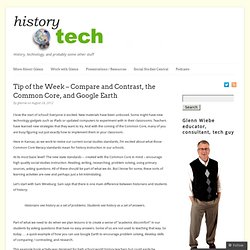
Everyone is excited. New materials have been unboxed. Some might have new technology gadgets such as iPads or updated computers to experiment with in their classrooms. Teachers have learned new strategies that they want to try. And with the coming of the Common Core, many of you are busy figuring out just exactly how to implement them in your classroom. Here in Kansas, as we work to revise our current social studies standards, I’m excited about what those Common Core literacy standards mean for history instruction in our schools. At its most basic level? Let’s start with Sam Wineburg. Historians see history as a set of problems. Part of what we need to do when we plan lessons is to create a sense of “academic discomfort” in our students by asking questions that have no easy answers.
Technology, Social Studies, and the Common Core: Part II. This summer I have been working with Todd Whitten on how we can integrate the Common Core Standards for History/Social Studies into the classroom for this upcoming year.
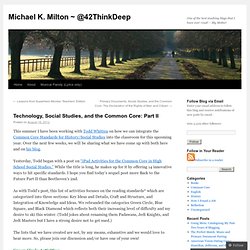
Over the next few weeks, we will be sharing what we have come up with both here and on his blog. Yesterday, Todd began with a post on “iPad Activities for the Common Core in High School Social Studies.” While the title is long, he makes up for it by offering 14 innovative ways to hit specific standards. I hope you find today’s sequel post more Back to the Future Part II than Beethoven’s 2nd. As with Todd’s post, this list of activities focuses on the reading standards* which are categorized into three sections: Key Ideas and Details, Craft and Structure, and Integration of Knowledge and Ideas. The lists that we have created are not, by any means, exhaustive and we would love to hear more.
27 SS writing prompts. Common Core State Standards: Literacy in History/Social Studies, Science, & Technical Subjects. Primary Source Materials & Document Based Questions. Primary Source Materials & Document Based QuestionsAn Internet Hotlist on Document Based Questions created by Paula GoldsteinNassau BOCES Introduction | Primary Source Materials | Document Based Questions | Assessments | General Resources | Constructed Response Questions Introduction Don't depend on someone else's interpretation of a document. The DBQ Project. Content CC Specifications. Rubric for Hist/SS Grades 11-12. History 75 Curriculum Units Reading Like a Historian. The Reading Like a Historian curriculum engages students in historical inquiry.

Each lesson revolves around a central historical question and features sets of primary documents modified for groups of students with diverse reading skills and abilities. This curriculum teaches students how to investigate historical questions employing reading strategies such as sourcing, contextualizing, corroborating, and close reading. Instead of memorizing historical facts, students evaluate the trustworthiness of multiple perspectives on issues from King Philip's War to the Montgomery Bus Boycott, and make historical claims backed by documentary evidence. I am so excited to find your website and your lessons. I will begin working with my students on learning how to read like a historian. Karen Peyer, Teacher, Russell Middle School, Colorado Springs How do I use these lessons in my classroom? 1. *Note: United Streaming requires a subscription to Discovery Education. 2. 3.
Of course! Branding the Presidents of the United States. US History / English Units - Download. Social Studies & Language Arts. Read Like a Historian Curr. Units. High School (Grades 9-12) U.S. History Activities, Lesson Plans, Worksheets. US History / English Units - Download. US History Websites with the Common Core. Forty-five states have implemented the Common Core State Standards in ELA and Mathematics for every subject.
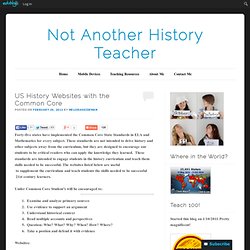
These standards are not intended to drive history and other subjects away from the curriculum, but they are designed to encourage our students to be critical readers who can apply the knowledge they learned. These standards are intended to engage students in the history curriculum and teach them skills needed to be successful. The websites listed below are useful to supplement the curriculum and teach students the skills needed to be successful 21st century learners. DBQ Questions. Document Based Questions. History Engine: Tools for Collaborative Education and Research. LiteracyContentFramework. CC History & Social Studies Modules. Reading Strategies for Social Studies. Reading Strategies for Social Studies.
Document Library. Primary Source Materials & Document Based Questions. Primary Sources with Document-based Questions. • Macartney and the Emperor The Qing dynasty's restrictions on foreign trade increasingly frustrated Europeans, especially the British.
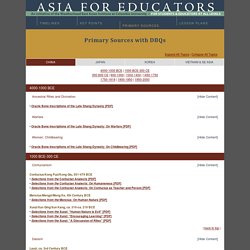
In 1792 Great Britain sent a diplomat, Lord George Macartney (1737-1806), to present its demands to the Qianlong emperor (r. 1736-1796). This unit includes an introductory note to teachers with suggestions for teaching about Macartney's mission; a student reading discussing European contact and trade with China prior to and on the eve of Macartney's mission to China; and the primary-source reading Two Edicts from the Qianlong Emperor, which were the Qianlong emperor's responses to the Macartney mission. US History Websites with the Common Core. Who Am I?: A History Mystery. Learning Resources. Exhibition Self-Guide Use this guide to enhance your visit!
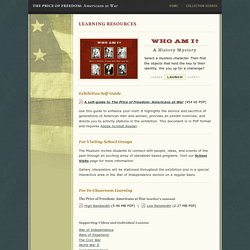
It highlights the service and sacrifice of generations of American men and women, provides an exhibit overview, and directs you to activity stations in the exhibition. This document is in PDF format and requires Adobe Acrobat Reader. For Visiting School Groups The Museum invites students to connect with people, ideas, and events of the past through an exciting array of standards-based programs. Gallery interpreters will be stationed throughout the exhibition and in a special interactive area in the War of Independence section on a regular basis. High School (Grades 9-12) World History Activities, Lesson Plans, Worksheets. The History Project - University of California, Davis. The Marchand Archive is an ever-expanding collection of document-based lesson plans (Documentary Source Problems) and more than 8,600 images (Image Archive).

This site brings together the original Adventures in Roland Marchand's File Cabinet launched in 1999 and the Marchand Image Archive launched in 2001. With funding from the National Endowment for the Humanities, we have expanded the original Marchand image collection to include images from other UC Davis faculty including Andres Resendez, Alan Taylor, Cynthia Brantley, Joan Cadden, Louis Warren, and Karen Halttunen (now at USC). We have supplemented Roland's documentary source problems with lessons based on images in this expanded collection and developed by outstanding teachers associated with The History Project. The Marchand Archive contains two useful collections: the Image Collection and the Documentary Source Problems Collection. Read more about each below. How Reliable Are the Social Sciences?
The Stone is a forum for contemporary philosophers and other thinkers on issues both timely and timeless.

Public policy debates often involve appeals to results of work in social sciences like economics and sociology. For example, in his State of the Union address this year, President Obama cited a recent high-profile study to support his emphasis on evaluating teachers by their students’ test scores. The study purportedly shows that students with teachers who raise their standardized test scores are “more likely to attend college, earn higher salaries, live in better neighborhoods and save more for retirement.” Beware the journalistically exciting result. Teacher Resources.
The Library of Congress offers classroom materials and professional development to help teachers effectively use primary sources from the Library's vast digital collections in their teaching. Find Library of Congress lesson plans and more that meet Common Core standards, state content standards, and the standards of national organizations. Discover and discuss ways to bring the power of Library of Congress primary sources into the classroom. Go to the blog Subscribe to the blog via e-mail or RSS. Using Primary Sources. History Animated. United States History: Early Years: Interactive Lesson Summaries. Playing History. HistoryBuff.com. Top 6 Sites for Primary Source Materials. It is officially August and most educators are beginning to feel the pressure that is the beginning of school.
As we start to look at rosters and enrollment, we start to pull out and revamp old lesson plans and search for new material. As a History Teacher (with a background in archaeology) I understand the relevance and importance of primary sources in the classroom. Primary sources are not solely essays or primary works, but art, photographs, and other avenues of popular culture. Finding primary source documents on the web can sometimes be a bit of a scavenger hunt.
I know that I have spent hours scouring the web for good translations, excerpted texts, or relevant materials. In this article, I am focusing on six websites that focus on providing primary sources for educators and students. 1. What sets Milestone apart from the free resources listed below is that each document is predicated with a succinct contextual/historical statement. 2. 3. 4. 5. 6. Top 6 Sites for Primary Source Materials. Center for Civic Education. American Memory from the Library of Congress - Home Page. Ushistory.org. A Flat World and Our Place In It. United States History: Early Years. American History From About. Ulysses S. Grant Memorial. Teaching with Primary Sources Journal For Teachers.